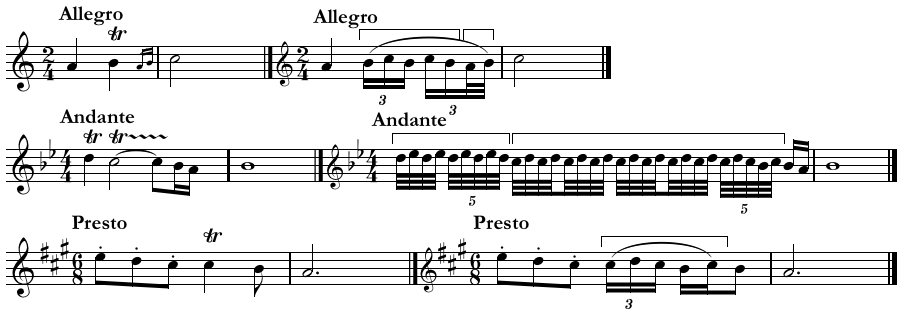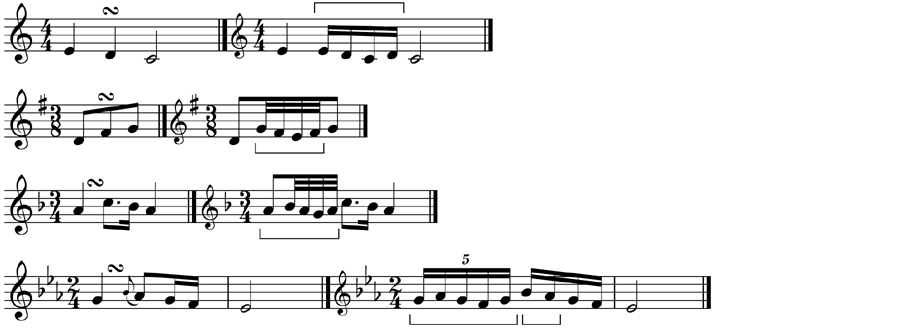Ornaments
In this guide...
Key terms:
Subscription required!
To view the complete study guide, you will need a valid subscription. Why not subscribe now?
Already have a subscription? Make sure you login first!
Introduction
As well as the many descriptive terms and the accents and articulations which we have already covered, there is a special set of symbols which require special attention: ornaments.
Ornaments
Ornaments are special "shortcut" symbols that tell the performer to play a specific pattern of notes, without actually showing them the notes.
They are called "ornaments" because they decorate or embellish the underlying music, and while they are often an essential stylistic aspect of the music, they can be considered additions to the music itself. Indeed, the style of performance of ornaments changed considerably between the 17th and 19th century, although the basic shapes that you need to learn remained the same throughout.
This study guide examines each of the basic ornaments in turn and shows you how to recognise their characteristic patterns. The table below provides a summary of these ornaments:
| Name | Notation | Pattern |
|---|---|---|
| acciaccatura also: crushed note, grace note |  |  |
| appoggiatura also: leaning note, grace note |  |  |
| trill also: shake |  |  |
| upper mordent |  |  |
| lower mordent |  |  |
| turn (over note) |  |  |
| turn (between notes) |  |  |
| inverted turn |  |  |
Ornaments in Baroque Music
There are in fact a number of other ornaments which are not covered here. These are most often found in Baroque music (the music in Europe of the late 16th century to the mid-18th century - for example that of the composers J.S. Bach, Handel, and Purcell), which is characterised by its sometimes extreme ornamentation.
There are many interesting issues regarding the most correct and idiomatic execution of the various ornaments used in this music which you will encounter if you go on to specialise in early music.
Grace notes
Grace notes appear as one or more small notes next to normal standard-sized notes, often attached to their associated notes with slurs. These small notes do not count towards the overall value of the bar - they are extra, and the total time value of the bar is the same with or without the grace notes. Therefore, the grace notes must, in performance, "steal" time from their associated notes.
There are two types of these notes; the acciaccatura (pronounced "atch-yack-a-too-ra", plural acciaccature) and the appoggiatura (pronounced "a-poj-ya-too-ra", plural appoggiature).
The difference between an acciaccatura and an appoggiatura is a bit tricky to spot: an acciaccatura has a small diagonal dash through its note-stem. They usually use small time values (demi-semiquavers, semiquavers, quavers) and appoggiature usually use semiquavers, quavers, and crotchets. Otherwise, they look just the same!
Look at this example to see the difference:
 The difference between an acciaccatura and an appoggiatura
The difference between an acciaccatura and an appoggiaturaThe acciaccatura
The acciaccatura is also known as a "crushed note", and is played as quickly as possible just before the associated note - "crushed" against it. Depending on the musical circumstances, the acciaccatura can be played just before the beat (with the main note on the beat), or it can itself be played on the beat. In other words, it can steal time from the note before, or from the main note, respectively.
The following example shows several acciaccature written in ornament form, and below each the corresponding versions written out in full.
 The acciaccatura
The acciaccaturaNote that some of these acciaccature have been written to occur before the beat, and some occur on the beat. Both are acceptable interpretations of this ornament.
The appoggiatura
The appoggiatura is also known as a "leaning note", and is played on the beat of its associated note, slightly accented, and stealing all the necessary time from the associated note. It thereby forces the associated note onto a weaker beat - the appoggiatura "leans" against it.
The amount of time "stolen" by the appoggiatura from its associated note depends on the length of the associated note:
- If the main note associated with the appoggiatura is not dotted, the appoggiatura normally takes up half the value of the main note.
- If the main note associated with the appoggiatura is dotted, the appoggiatura takes up two thirds the value of the main note. (In other words, the appoggiatura will take up all the time value of the main note, except for the value of the dot, which is left to the main note).
It is important to remember that the time value of the appoggiatura is not necessarily the same as the time value it will take when written out.
This example shows several appoggiature written in ornament form, and below each are the corresponding written out versions:
 The appoggiatura
The appoggiaturaNote that unlike the acciaccatura, the appoggiatura always occurs on the beat, and never before.
The trill
The trill (also known as a "shake") is simply a rapid alternation between two notes: the note written, and the note above it.
The trill - the rapid alternation - should continue for the full duration of the marked note (or the combined length of several notes that are tied together).
Often, and especially if the trill leads immediately into a following note, a trill will end with a pattern that resembles the turn (see below for a description of the turn). This pattern requires that the note below the marked note be played just before the final occurrence of the marked note. This sounds complicated, but in practice is quite simple - try playing some of the examples below. Sometimes, this extra closing pattern is notated using grace notes.
The following example shows some trills and, next to each, their written-out versions.
 The trill
The trillNote how the written-out version contains more notes depending on how fast the tempo is, and also note the different versions of the trill closing pattern.
The mordent
There are two versions of the mordent: the upper mordent and lower mordent. Both involve rapidly playing the note above (for an upper mordent) or the note below (for a lower mordent) in alternation with the marked note. In this respect they are like a very short trill.
Here are both types of mordent and their written-out versions:
 The mordent
The mordentNote that in some music of the 17th and 18th century, the upper mordent would be performed starting on the note above, and would be extended to form a short trill. The lower mordent would be performed in the way described above, but could also be extended.
Sometimes, the mordent will require the extra note (i.e., the note with which the marked note will alternate) to be a note that is not in the key of the music. If you were to write out the mordent in this situation, you would use an accidental, and so in the ornament form, the mordent has the correct accidental added above or below.
The following example illustrates this. Note that this is most common in minor keys, or where the music is undergoing a modulation to a different key (in this example, the music is modulating from G major to D major).
 Mordents with accidentals
Mordents with accidentalsThe turn
The turn is a group of notes that follow a characteristic pattern or order in relation to the marked note:
- The note above
- The note itself
- The note below
- The note itself again
The turn can be written either over a note, in which case the ornament is performed beginning on the note above the marked note, or it can be written between two notes, in which case the first note is played, then the turn is played (beginning on the note above the first note).
In both cases, the overall duration of the affected notes remains the same. The notes of the turn "steal" their required time from either the marked note (if the turn is written above a note) or from the first note (if the turn is written between two notes).
The following examples show these two forms of the turn, and the written-out versions that you would play.
 The turn: note that the final example also includes an appoggiatura
The turn: note that the final example also includes an appoggiaturaThe turn is not always performed with even-length notes, and the precise performance depends on the style and speed of the music. The first three notes are always the same duration, but the fourth note can be longer.
When a turn is written over or after a dotted note, the fourth note of the turn always takes the time value represented by the dot (i.e., equal to half of the time value of the note that is dotted).
The next example shows written-out versions of turns with uneven length notes, and turns written with dotted notes.
 More turns
More turnsAs you can see, the turn can also be affected by accidentals in the same way as described above for a mordent, particularly in a minor key (to take account of the raised leading note) and when modulating. If the note above is affected, then an accidental is written above the turn, and if the note below is affected, then an accidental is written below the turn. It is therefore possible for accidentals to appear both above and below the turn.
The inverted turn
The inverted turn is simply an "upside down" version of the normal turn, and is encountered much less often.
It can be written in two ways (as shown in the table at the top of the page) - either the same as a normal turn but with a vertical line through, or as an upside-down version of the normal turn.
The pattern is the opposite to that of the normal turn:
- The note below
- The note itself
- The note above
- The note itself again
If you have to write down the symbol for a turn, therefore, make sure you get it the right way up, and that you don't write an inverted turn by mistake!
Learning tip
You will need to be able to recognise and name all of these ornaments.
In an exam, you will normally be given an extract of music which includes an ornament, and you will be asked to give its name. Note that you will need to be able to spell correctly "acciaccatura" (double C, double C) and "appoggiatura" (double P, double G).
Alternatively, you may be given a written-out ornament, in which case you will be asked to write down (and maybe also name) the corresponding symbol - this is particularly often the case with a turn, so make sure you can write the symbol for a turn the right way up, and not an inverted turn!
It is easy to remember the correct way to write down a turn: it goes up first, then down, just the same as the shape the notes follow. Likewise, the inverted turn also follows the shape of the notes of an inverted turn.
Read more...
With a subscription to Clements Theory you'll be able to read this and dozens of other study guides, along with thousands of practice questions and more! Why not subscribe now?